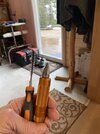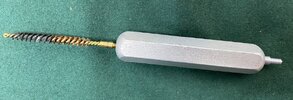Charlie98
Member
I wet tumble with pins, then use One Shot at a steep angle to get just a little bit in the case mouth. This is before resizing. I've never needed to do anything to help with bullet seating.
That's what I do, but with dry tumbling. OneShot to size, and then back in the tumbler again to get the lube off.
I don't consider the bushing as cleaning but rather just a way to apply dry lube.
That's how I understand it. I bought the Lyman version of the doodad Okie posted... and in 30+ years have never used it, beyond experimenting with it to see what it did. I may have even thrown it out, already, but I still have the half-pint can of Midway mica as well, gathering dust. When I bought my Lyman Case Prep machine, it, too, came with nylon neck brushes and a tiny thimble of mica dry lube... that seems to make more sense if you are already setting there chamfering case mouths... as part of the process. I'll have to think about that.
Understanding what neck tension does, I don't see how a lube, even a dry lube, would be beneficial to neck tension... it seems like it would be detrimental to neck tension. A nylon dry-brushed neck? Ok. A bronze brush? No way.



